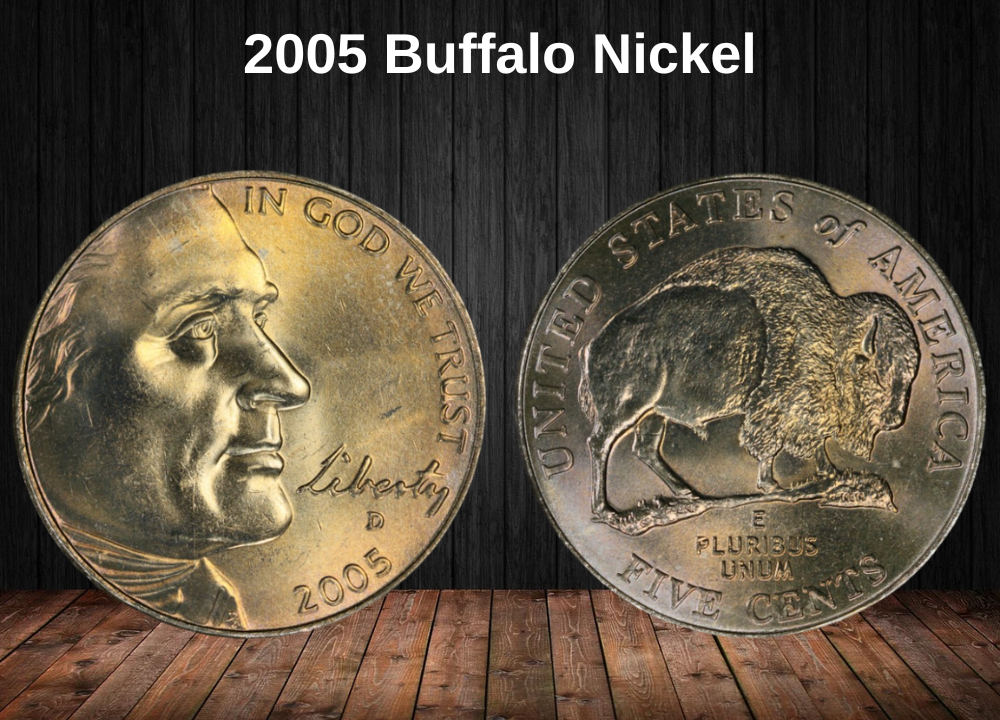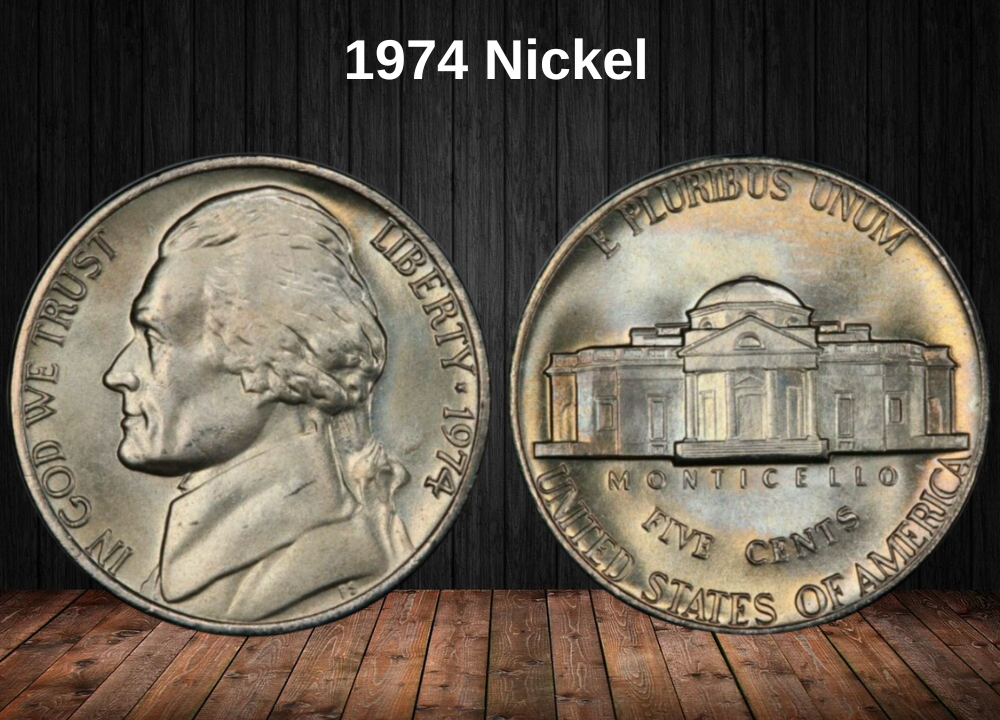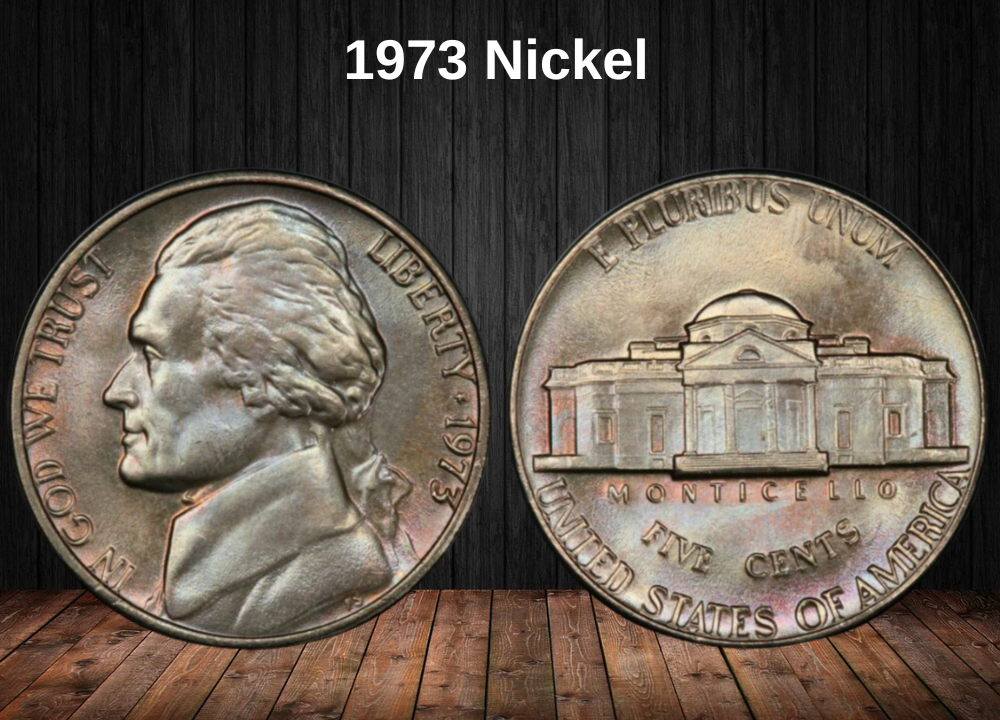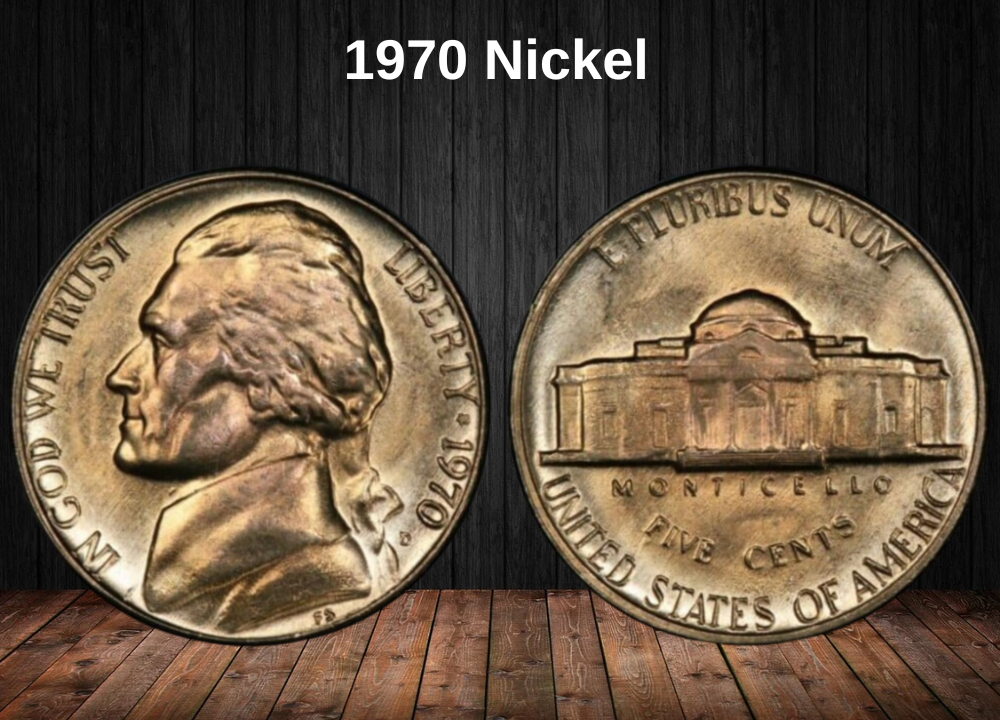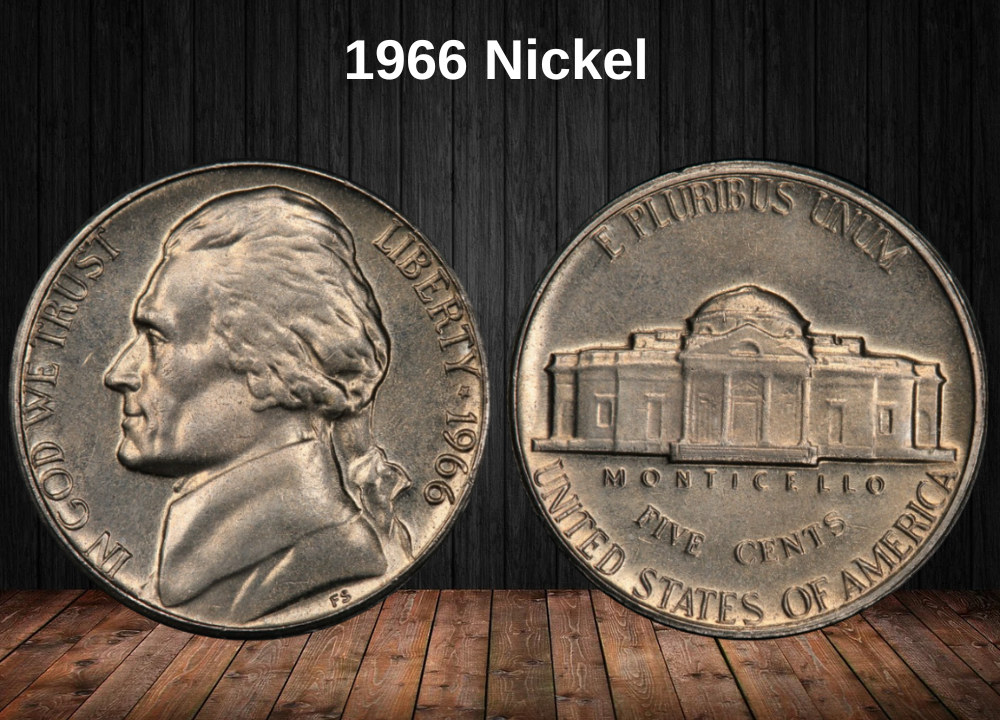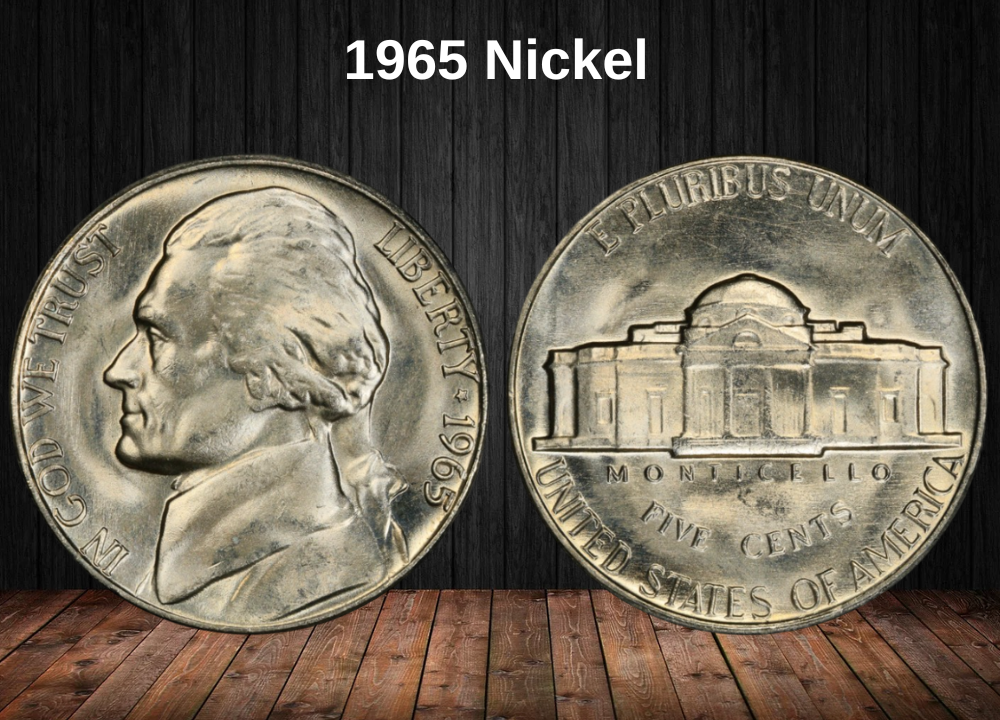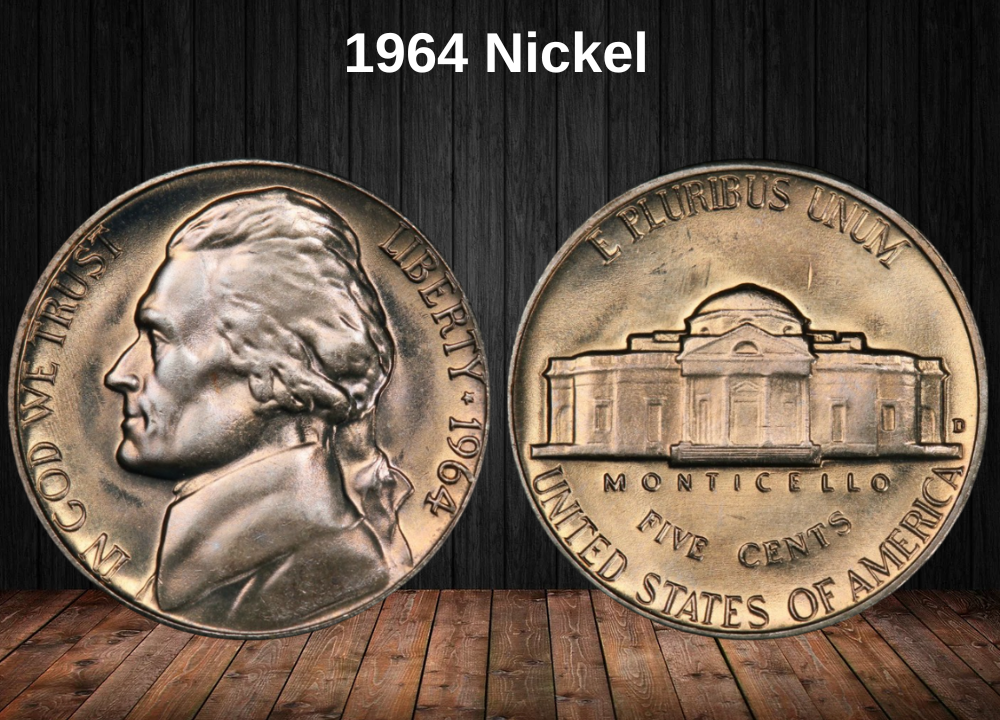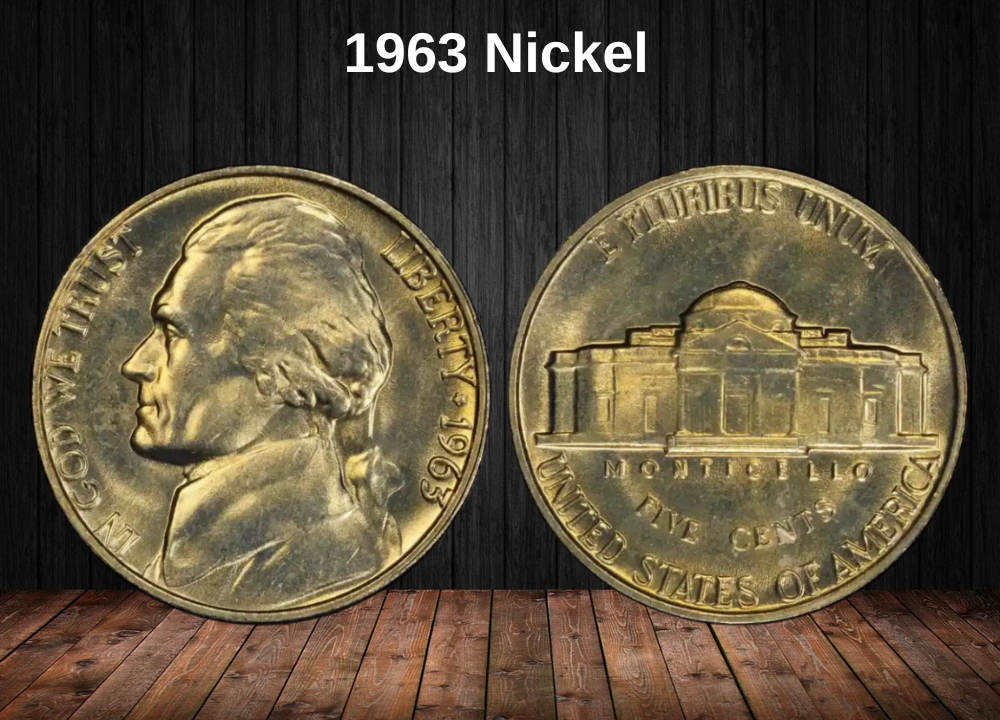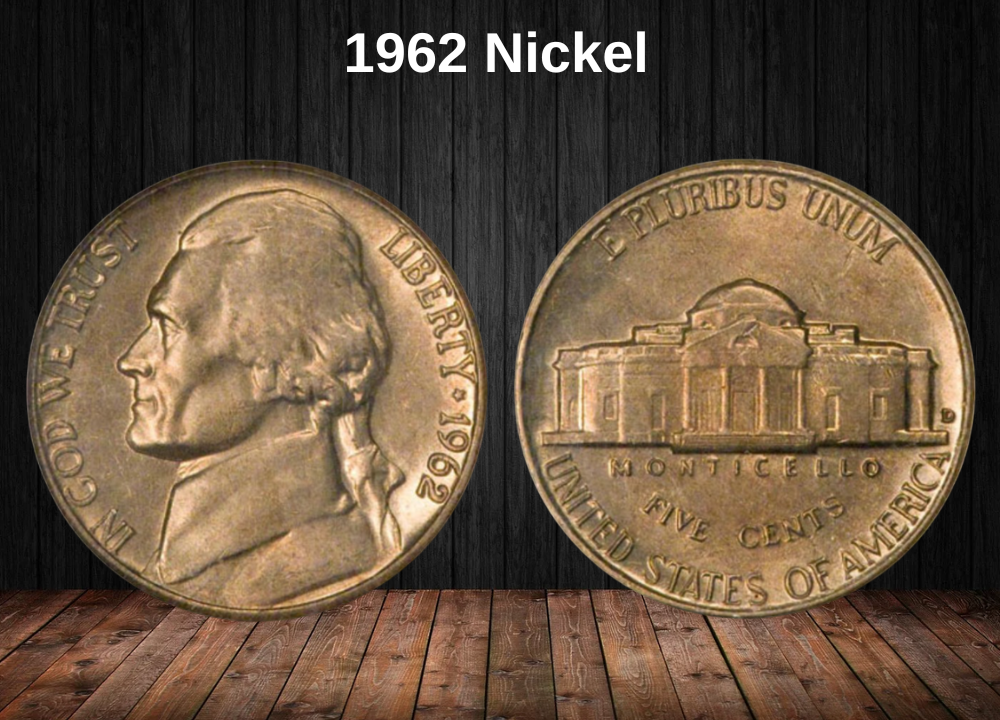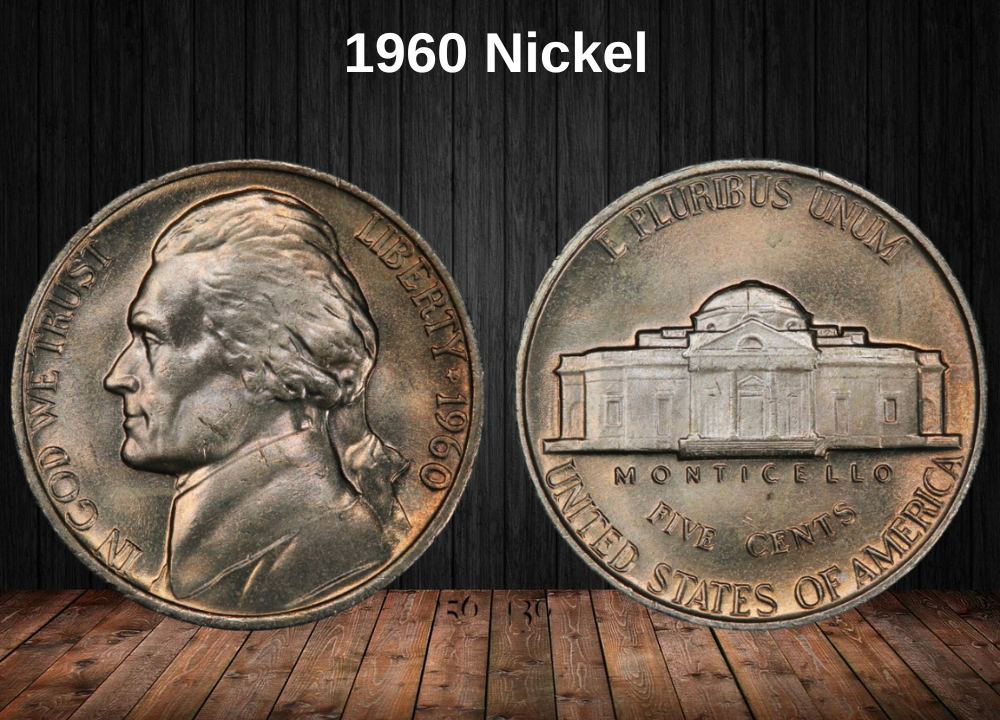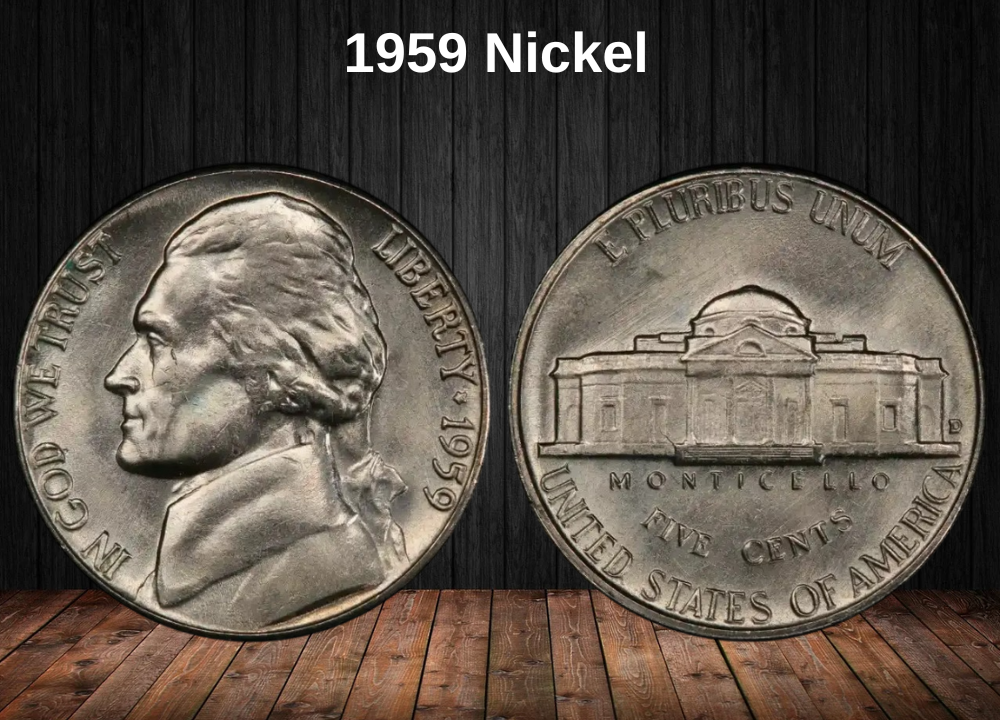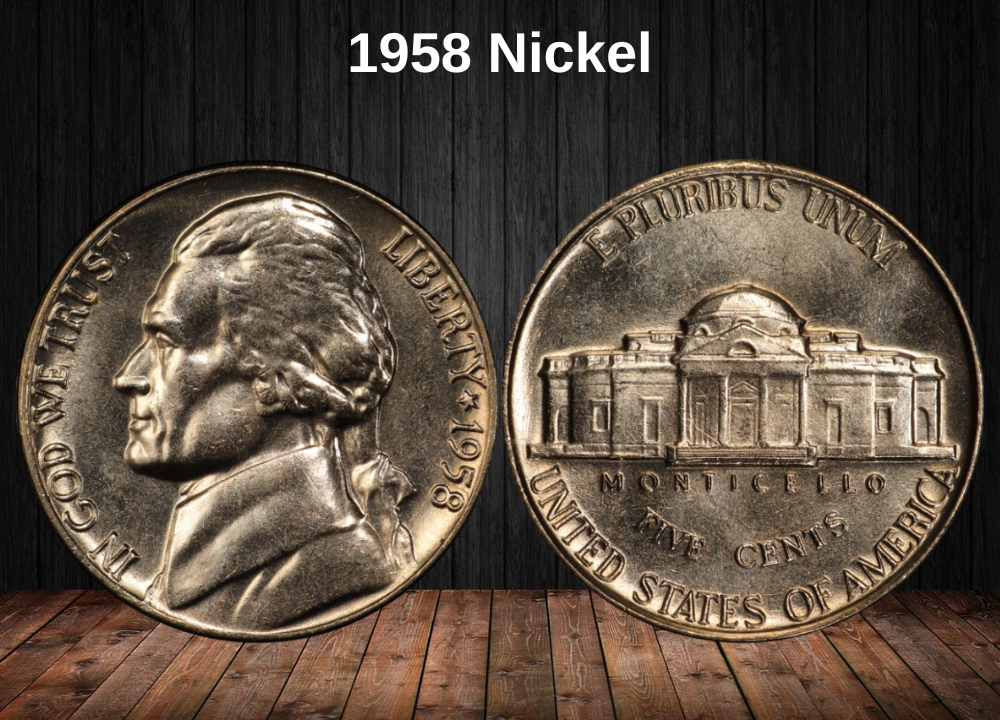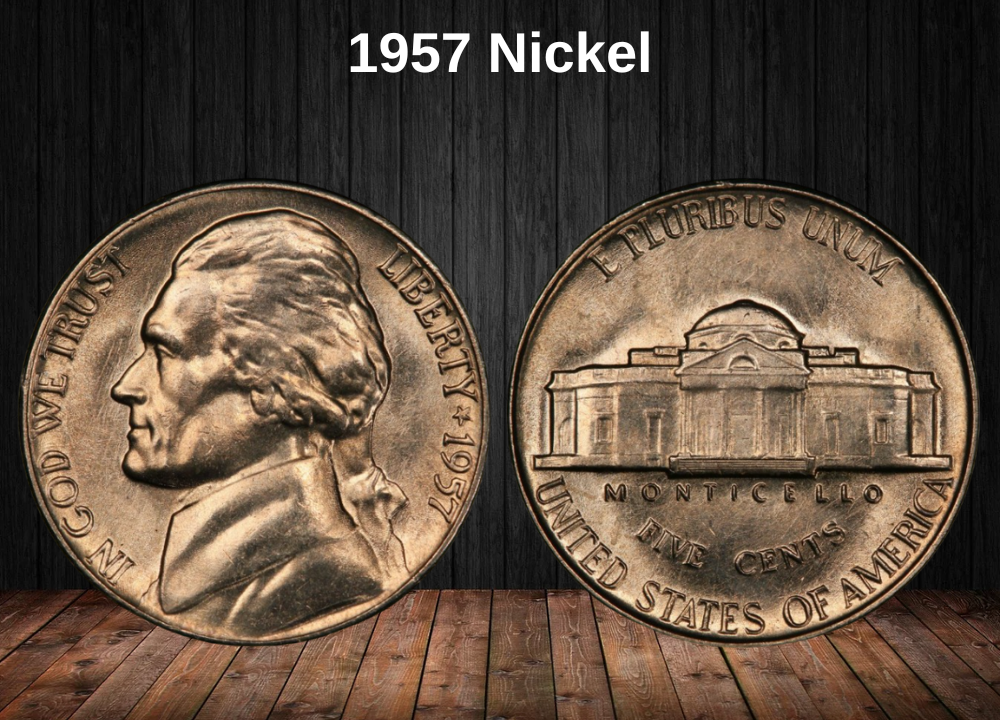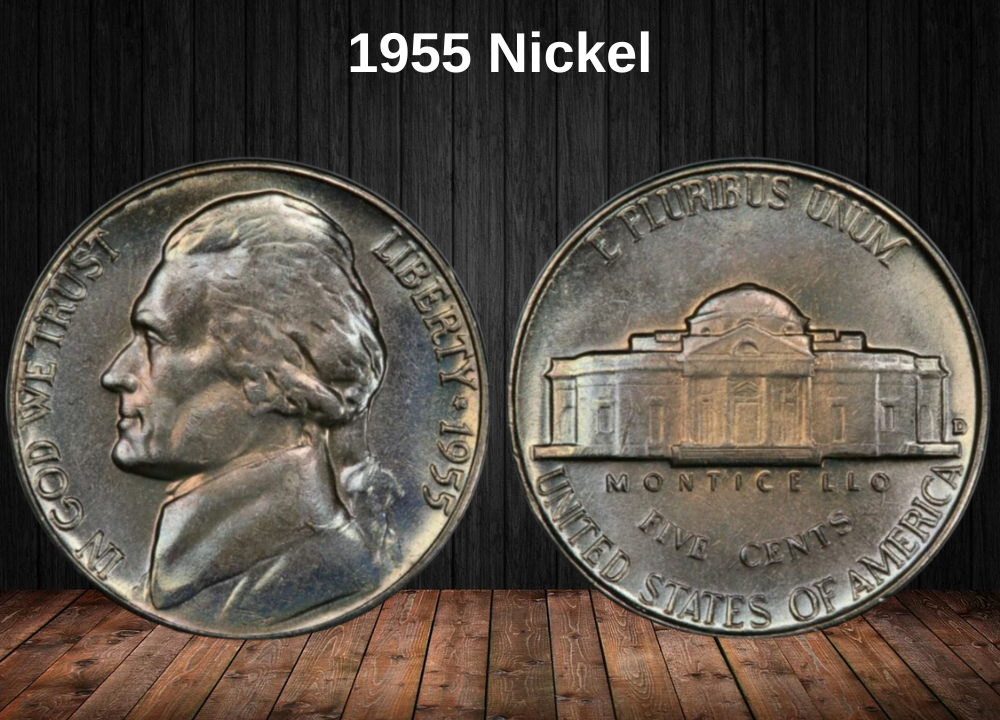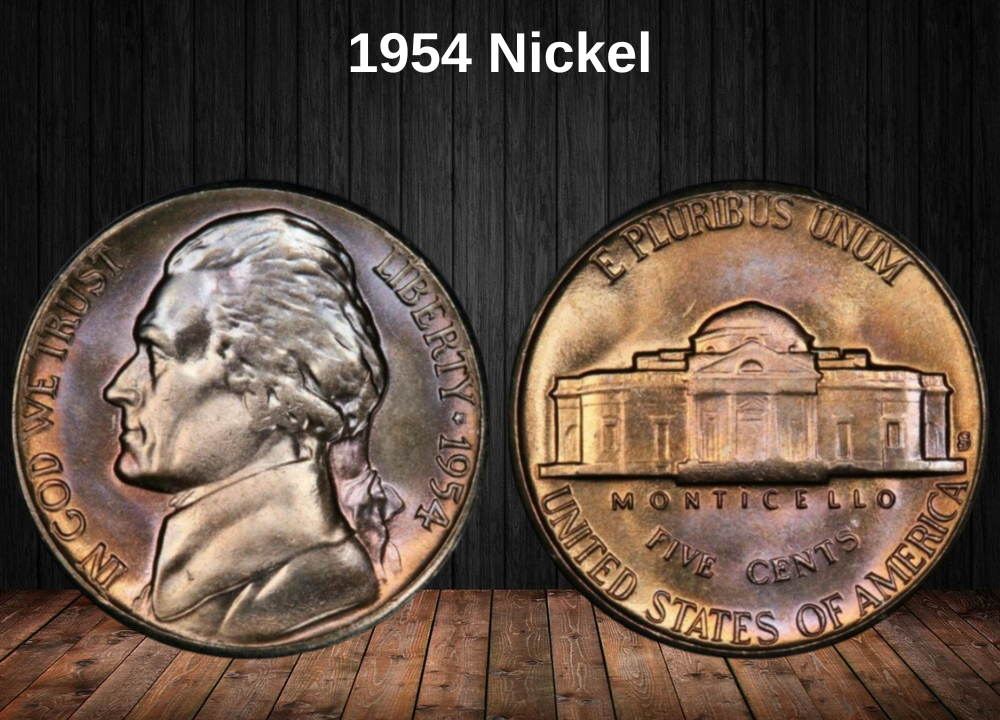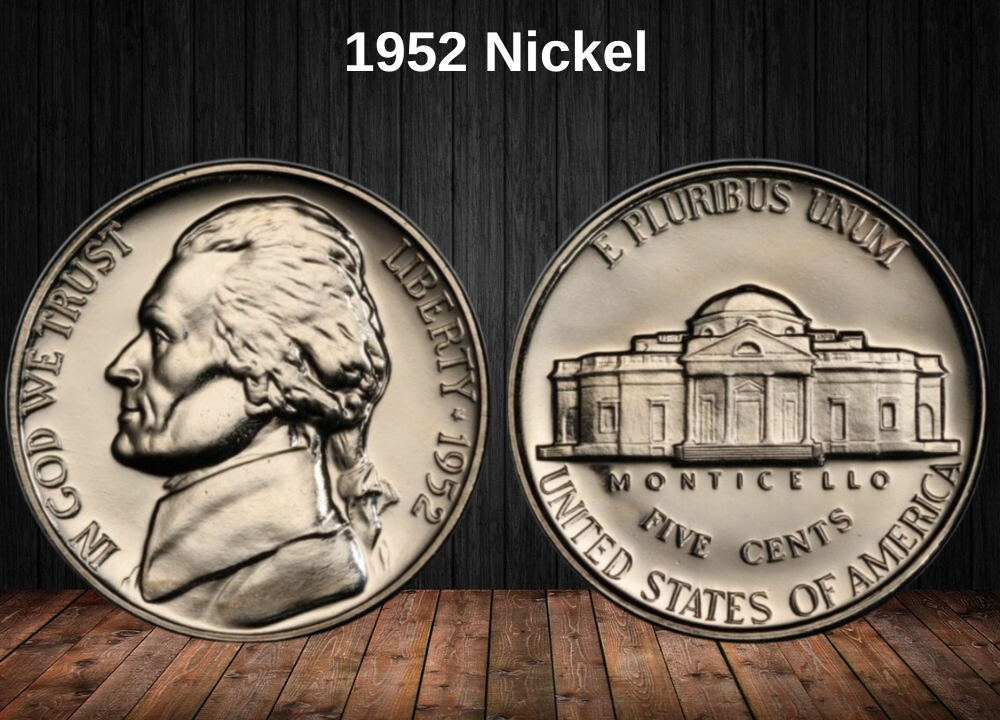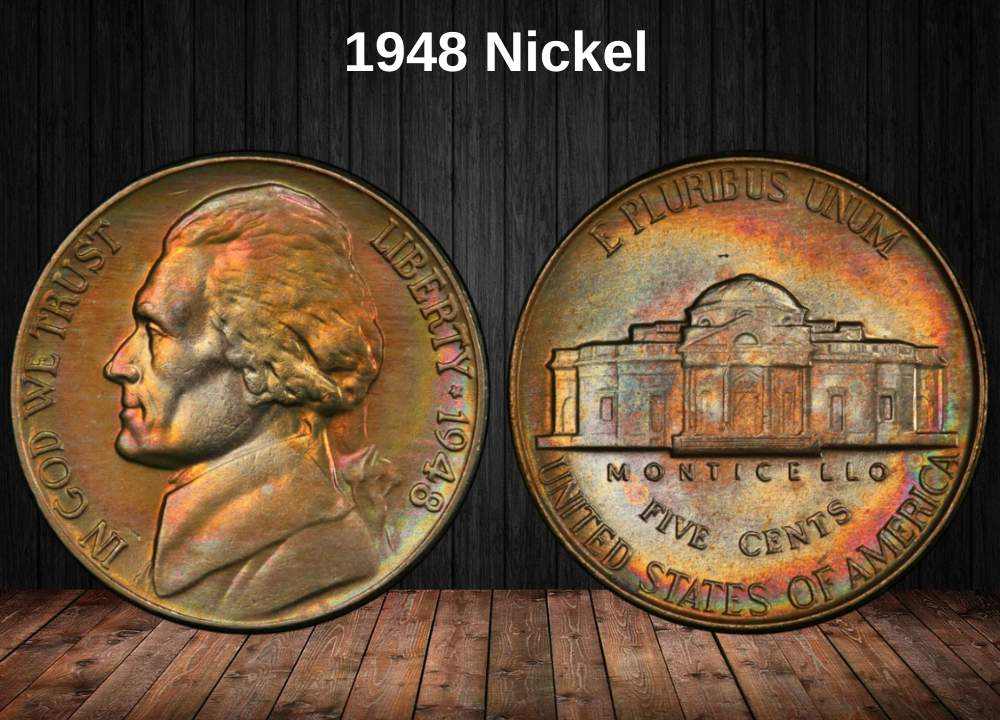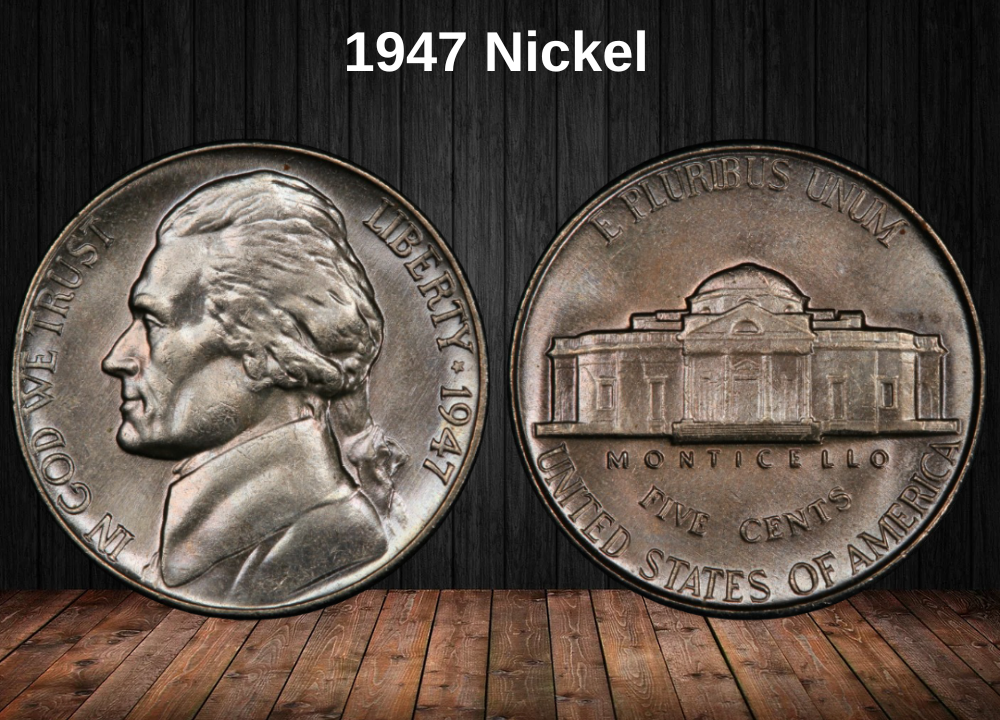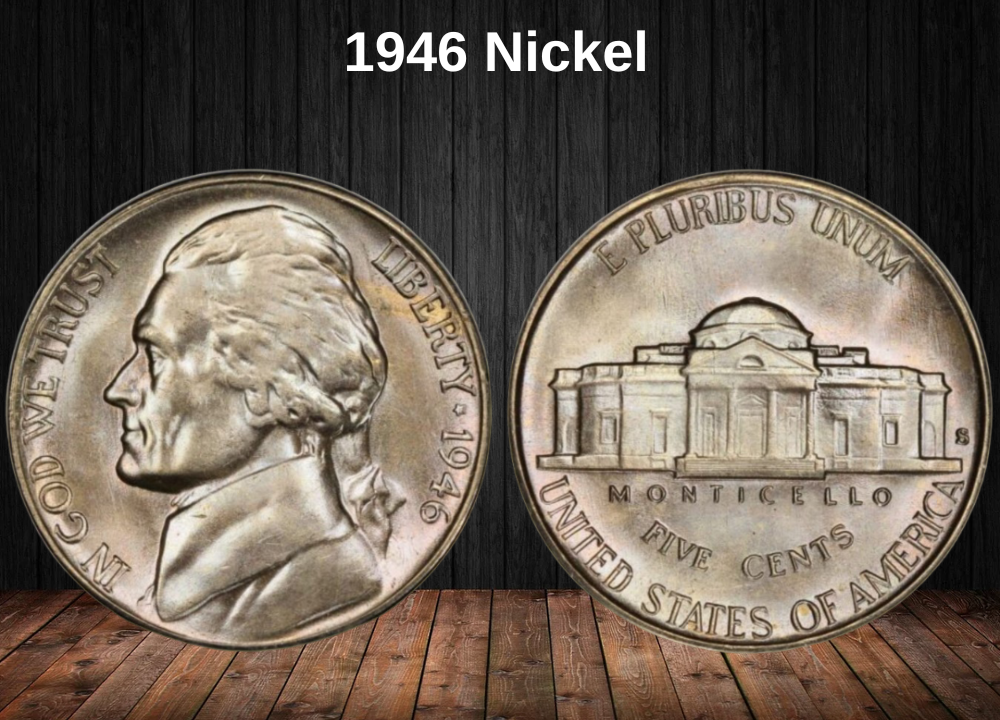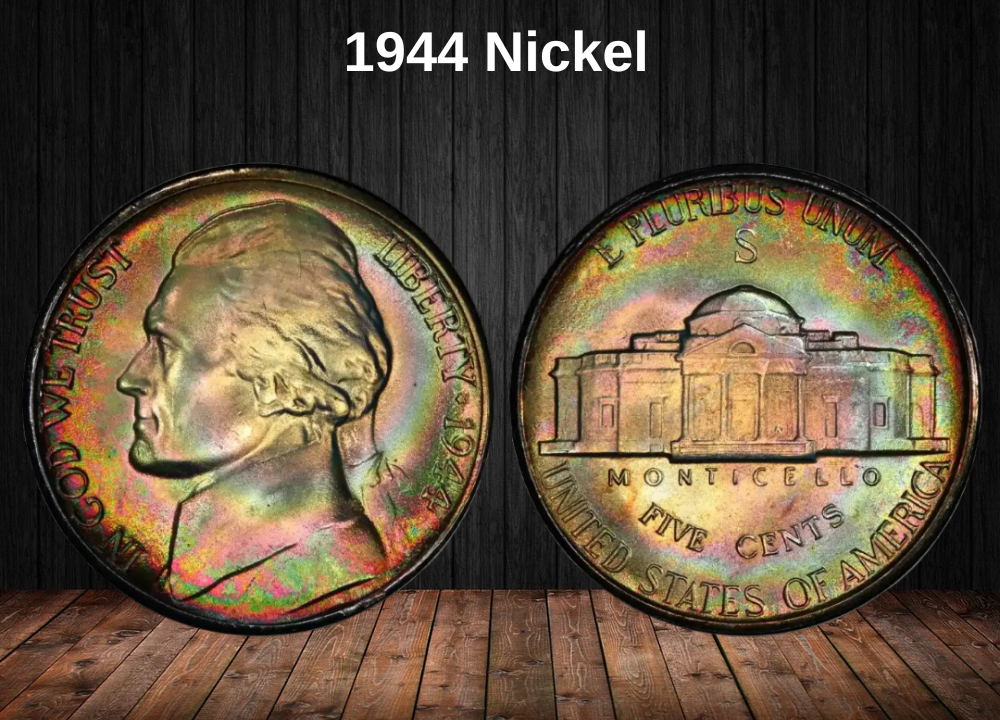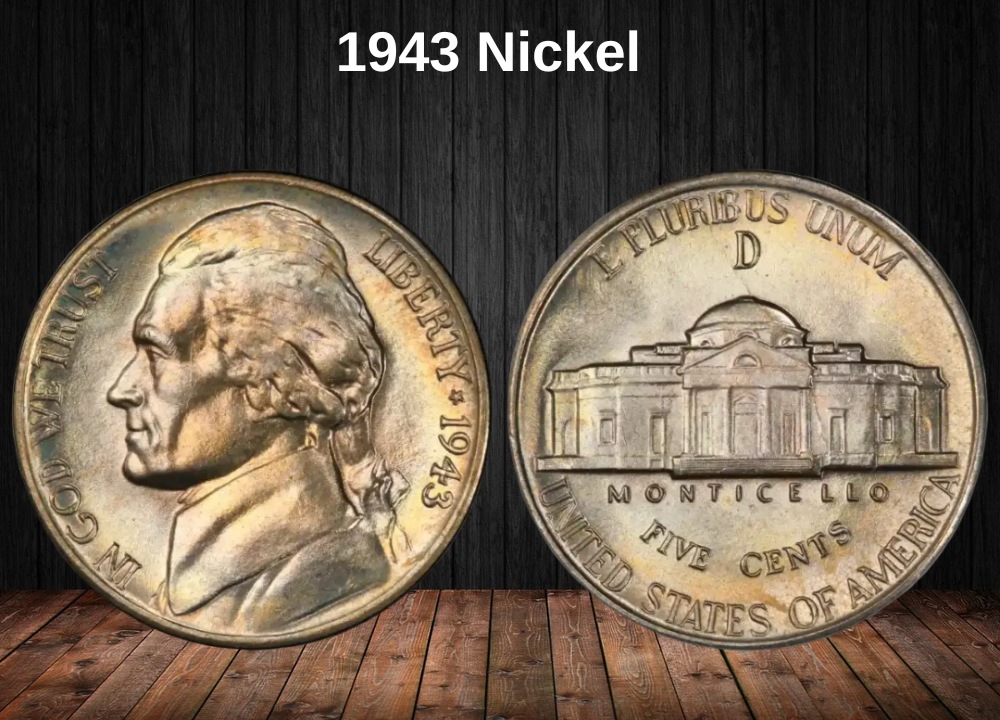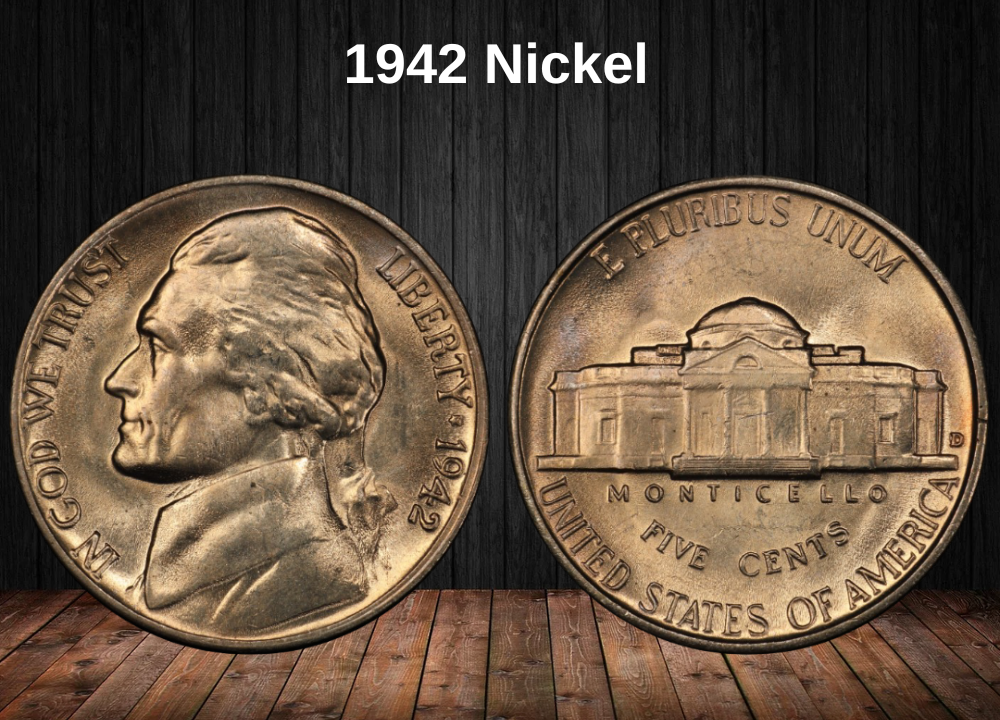In 1938, the U.S. Mint retired the beloved Buffalo nickel and introduced a fresh design—the Jefferson nickel, created by sculptor Felix Schlag. This new five-cent piece, made from a copper-nickel alloy, remained in circulation with only minor design changes until 2004.
Although early Jefferson nickels are often overlooked by seasoned collectors, the 1941 issue holds value as a great entry-level coin for beginners. With a few exceptions that have sold for thousands, most 1941 nickels remain affordable and readily available. Still, many collectors appreciate them for their historical significance and clean, classic design.
1941 Jefferson Nickel Value Chart
| Condition | 1941 (No Mint Mark) | 1941-D Nickel | 1941-S Nickel |
|---|---|---|---|
| Good (G-4) | $0.12 | $0.12 | $0.12 |
| Very Good (VG-8) | $0.18 | $0.18 | $0.18 |
| Fine (F-12) | $0.24 | $0.24 | $0.24 |
| Very Fine (VF-20) | $0.30 | $0.42 | $0.42 |
| Extra Fine (EF-40) | $0.60 | $0.84 | $0.84 |
| About Uncirculated (AU-50) | $0.90 | $1.22 | $1.22 |
| Mint State 60 (MS60) | $1.84 | $3.01 | $2.73 |
| Mint State 65 (MS65) | $18 | $18 | $18 |
| Proof 65 (PR65) | $128 | – | – |
Note: Only the Philadelphia Mint produced proof nickels in 1941, which explains the absence of PR65 values for the Denver and San Francisco issues.
History of the 1941 Jefferson Nickel

Although we associate the nickel with the five-cent denomination today, these weren’t the first coins of their kind in U.S. history. The earliest five-cent pieces were actually silver half dimes, first minted in 1792 shortly after the founding of the U.S. Mint. These half dimes remained in circulation until 1873.
After the Civil War, the government began producing small-denomination coins using base metals instead of silver or gold. Congress authorized new coins made from a copper-nickel alloy, beginning with the Shield nickel (1866–1883). This was followed by:
- Liberty Head (V) nickels (1883–1913)
- Buffalo (Indian Head) nickels (1913–1938)
In 1938, the U.S. Mint launched the Jefferson nickel, designed by Felix Schlag, to honor Thomas Jefferson, the nation’s third President and the primary author of the Declaration of Independence.
1941 Jefferson Nickel Mintages
| Mint Location | Coin Type | Mintage |
|---|---|---|
| Philadelphia | 1941 (no mint mark) | 203,265,000 |
| Philadelphia | 1941 Proof Nickel | 18,720 |
| Denver | 1941-D | 53,432,000 |
| San Francisco | 1941-S | 43,445,000 |
| Total | 300,160,720 |
In 1941, the design remained unchanged, but just one year later (in mid-1942), a metal composition change was made due to World War II. The U.S. needed nickel for wartime production, so coins from mid-1942 through 1945 were struck using a silver-based alloy, now known as wartime nickels.
In 2004 and 2005, the U.S. Mint temporarily changed the Jefferson nickel design to commemorate the bicentennial of the Lewis and Clark Expedition. These special issues were followed in 2006 by a permanent redesign:
- The reverse returned to Monticello.
- The obverse was updated with a front-facing portrait of Jefferson by Jamie Franki, replacing the original left-facing profile by Felix Schlag.
By 2016, the U.S. nickel celebrated its 130th anniversary. Ironically, due to rising production costs, each five-cent piece now costs over 7 cents to produce, making it one of the few coins regularly minted at a loss. To keep the nickel viable, future plans may involve the use of cheaper metals to reduce costs.
Features of the 1941 Jefferson Nickel
The obverse of the 1941 Jefferson Nickel
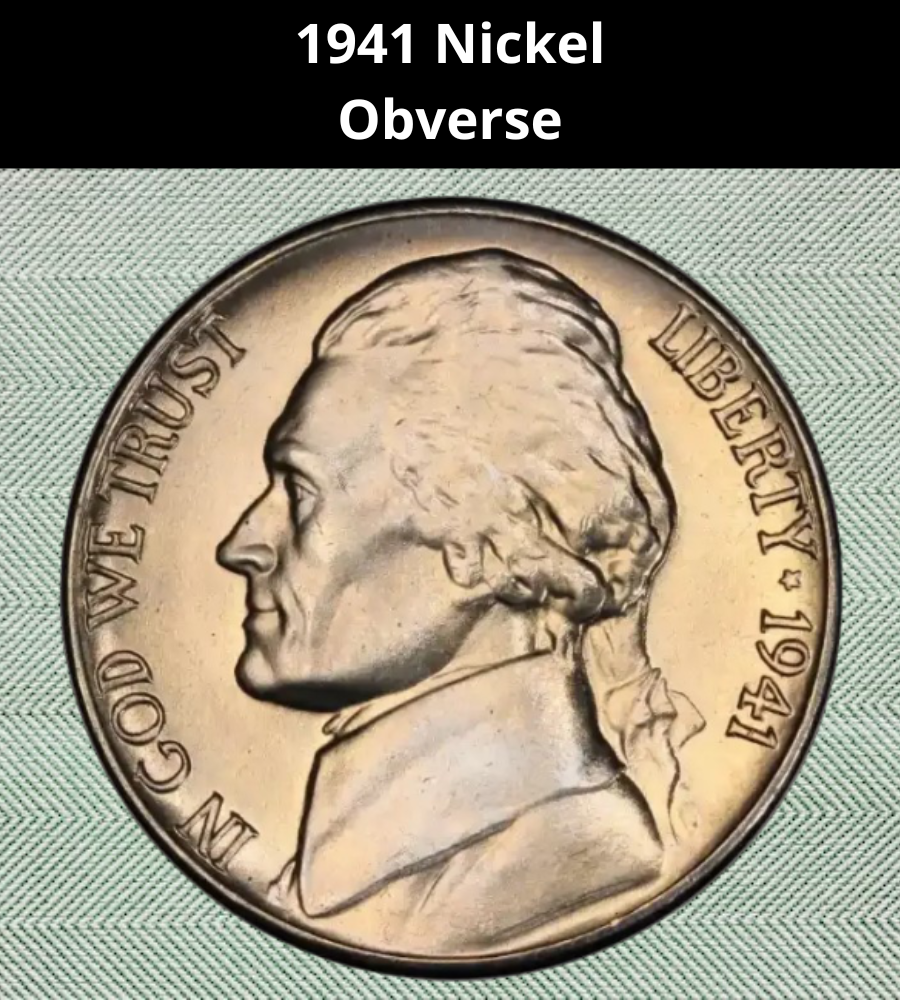
The obverse (front) of the 1941 Jefferson nickel features a left-facing portrait of Thomas Jefferson, the third President of the United States, designed by Felix Schlag.
The design is clean and formal, with two inscriptions framing Jefferson’s profile:
- On the left, along the rim, is the national motto: “IN GOD WE TRUST.”
- On the right, behind Jefferson’s head, you’ll see “LIBERTY” followed by a star and the date “1941.”
This elegant and balanced layout was part of Schlag’s winning design in a 1938 competition to redesign the nickel, and it remained largely unchanged for decades.
The reverse of the 1941 Jefferson nickel
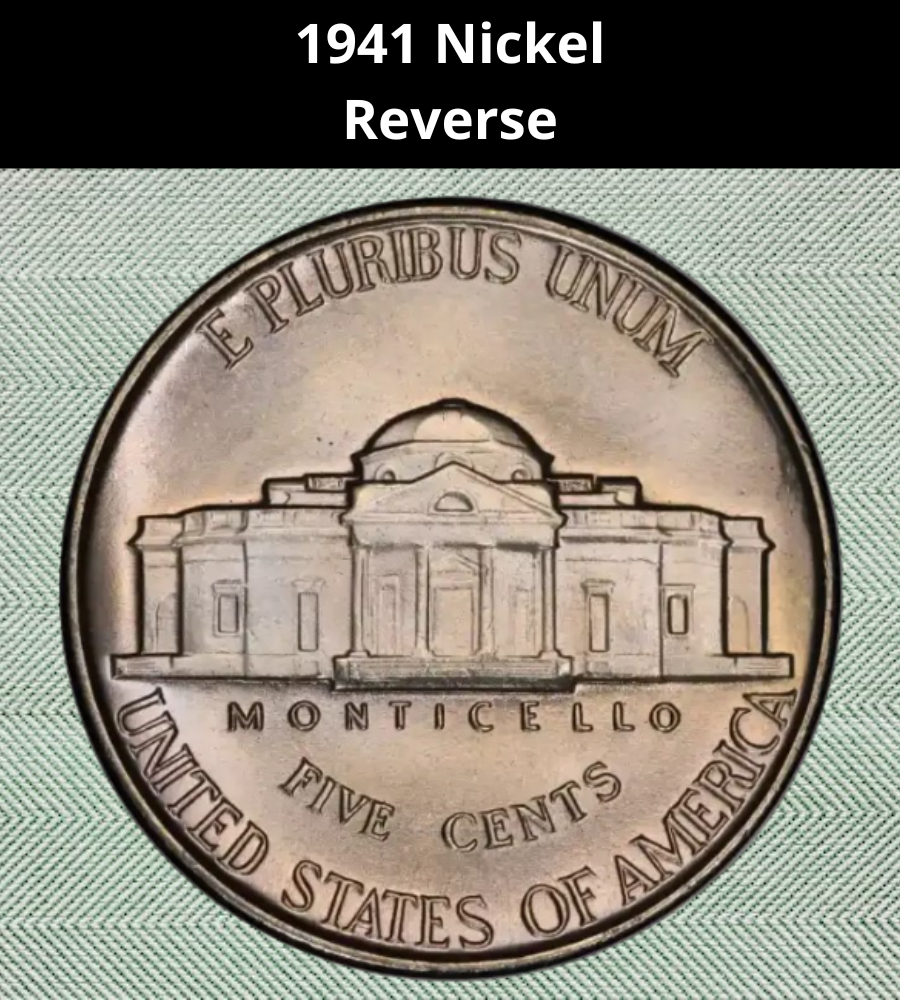
The reverse of the 1941 Jefferson nickel showcases a detailed front view of Monticello, Thomas Jefferson’s iconic estate in Virginia. This stately building sits at the center of the design, with four lines of text carefully arranged around it:
- At the top of the coin, just above the building’s dome, is the Latin motto: “E PLURIBUS UNUM”
- Below Monticello, the inscriptions appear in stacked order:
- “MONTICELLO” (naming Jefferson’s historic home)
- “FIVE CENTS” (the denomination, curved in a semi-circle)
- “UNITED STATES OF AMERICA” (the issuing country)
If the coin was minted in Denver or San Francisco, you’ll also find the mint mark (D or S) to the right of the building, next to the base of Monticello.
1941 Jefferson Nickel Specifications
| Feature | Details |
|---|---|
| Face Value | $0.05 (Five Cents) |
| Metal Composition | 75% Copper, 25% Nickel |
| Diameter | 0.835 inches (21.2 mm) |
| Thickness | 0.077 inches (1.95 mm) |
| Weight | 0.176 ounces (5.00 g) |
| Edge | Plain |
| Shape | Round |
The 1941 Jefferson nickel combines historic symbolism, durable materials, and simple elegance, making it a memorable part of mid-20th-century American coinage.
Additional Features of the 1941 Jefferson Nickel
The 1941 Jefferson nickel is a five-cent coin composed of a copper-nickel alloy—specifically 75% copper and 25% nickel. It has a plain (smooth) edge and a classic round shape.
In terms of physical specifications, the coin weighs approximately 0.176 ounces (5 grams), has a diameter of 0.835 inches (21.2 mm), and a thickness of 0.077 inches (1.95 mm). These dimensions remained consistent throughout the early Jefferson nickel series.
Thanks to its durable metal composition and historical design, the 1941 nickel continues to attract both new and seasoned collectors alike.
Grading the 1941 Jefferson Nickel
The value of a 1941 Jefferson nickel largely depends on its condition (or grade) and the mint mark it carries. Additionally, collectors place a premium on proof coins and those with the Full Steps designation—nickels that show all five or six steps on Monticello with clear, uninterrupted detail. These versions are often the most visually appealing and highly collectible in the series.
Grading Scale Overview
Coins are evaluated on the Sheldon Scale, which ranges from 1 to 70:
| Grade Number | Grade Description |
|---|---|
| 1 | Basal State-1 (barely identifiable) |
| 2 | Fair |
| 3 | Very Fair |
| 4–6 | Good |
| 7–10 | Very Good |
| 12–15 | Fine |
| 20–30 | Very Fine |
| 40 | Extremely Fine |
| 50 | About Uncirculated (AU50) |
| 60 | Mint State (MS60) |
| 65 | Mint State Choice (MS65) |
| 70 | Perfect Mint State (MS70) |
Coins that show no wear, retain their original luster, and have sharp details typically fall into the Mint State (MS) category and can command higher prices—especially if they exhibit Full Steps.
1941 Jefferson Nickel Value Guides
1941 No Mint Mark Nickel Value
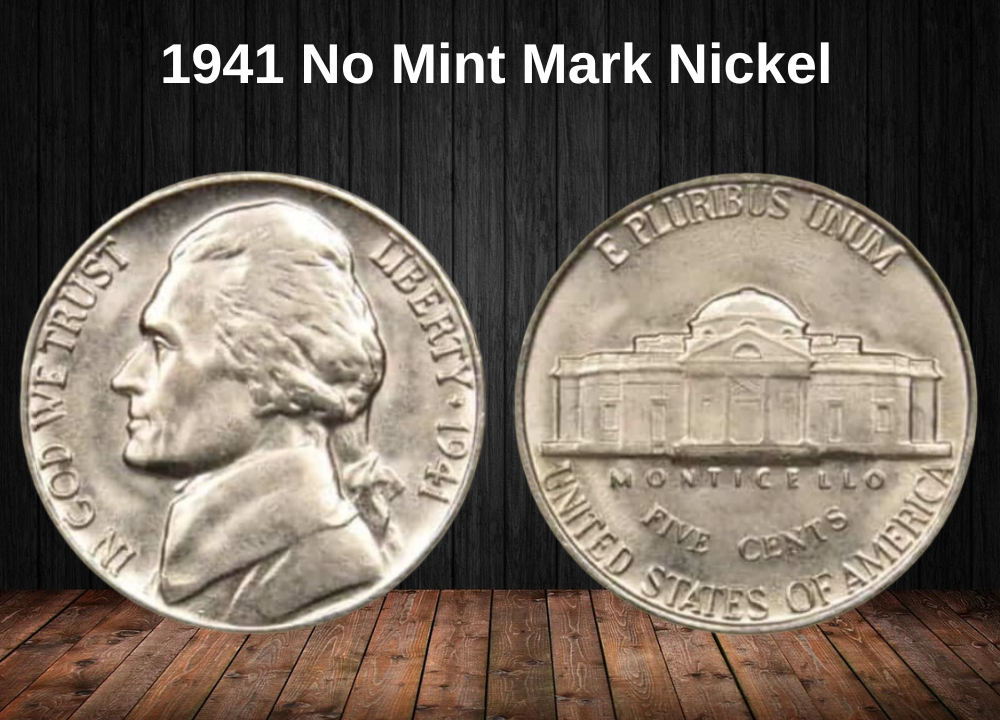
In 1941, the Philadelphia Mint produced a massive 203,265,000 Jefferson nickels for regular circulation—making it the most common variety of that year. Because of the high mintage, most circulated examples today hold modest value, rarely exceeding $1.
For example:
- A coin in Extra Fine (XF) condition is typically worth around $0.30
- An About Uncirculated (AU) example might sell for $0.50
Mint State (MS) Value Breakdown
If your 1941 nickel is in uncirculated condition, its value increases depending on its grade:
| Grade | Value |
|---|---|
| MS60–MS62 | $3 each |
| MS63 | $8 |
| MS64 | $14 |
| MS65 | $20 |
| MS66 | $30 |
| MS67 | $60 |
| MS68 | Up to $1,100 |
Full Steps (FS) Variety
Nickels with the Full Steps designation—showing complete, undisturbed steps on Monticello—are particularly desirable. Even these are relatively affordable compared to other key dates:
- Most FS nickels range from $25 to $600 depending on the grade
- A rare MS68 Full Steps nickel could reach values as high as $12,000
Despite being common overall, standout specimens can surprise collectors. For instance, in 2006, a 1941 No Mint Mark nickel graded MS67 sold at Superior Galleries for an impressive $5,175.
1941 Proof Nickel Value
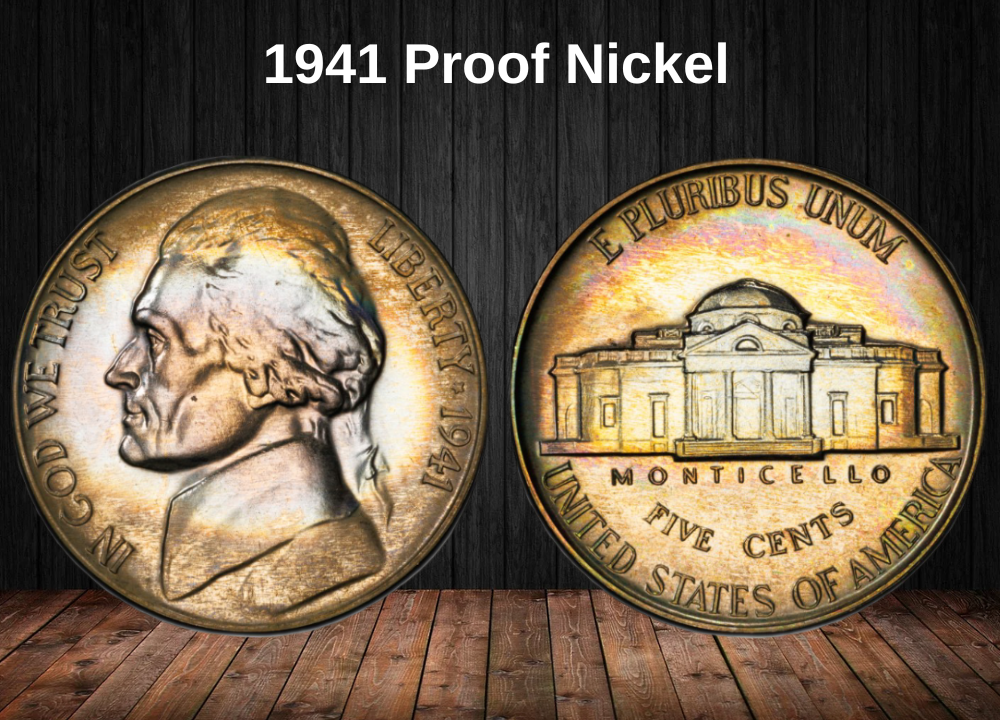
In 1941, the Philadelphia Mint struck only 18,720 proof Jefferson nickels, making them highly collectible today—especially in higher grades. These proofs were specially minted for collectors and feature sharp details, mirrored fields, and a satin-like finish.
The coin’s value increases significantly based on its Proof (PR) grade:
| Grade | Estimated Value |
|---|---|
| PR60 | $30 |
| PR61 | $32 |
| PR62 | $40 |
| PR63 | $55 |
| PR64 | $65 |
| PR65 | $75 |
| PR66 | $110 |
| PR67 | $350 |
| PR68 | Up to $9,000 |
The highest-graded 1941 proofs, particularly those at PR68, can command premium prices. In fact, a PR68 Jefferson proof nickel fetched an incredible $18,800 at a 2013 auction, making it the most valuable 1941 Jefferson nickel ever sold.
If you own a proof from this year, especially one in near-perfect condition, it’s worth having it certified and graded—you may have a hidden gem in your collection.
1941 D Nickel Value
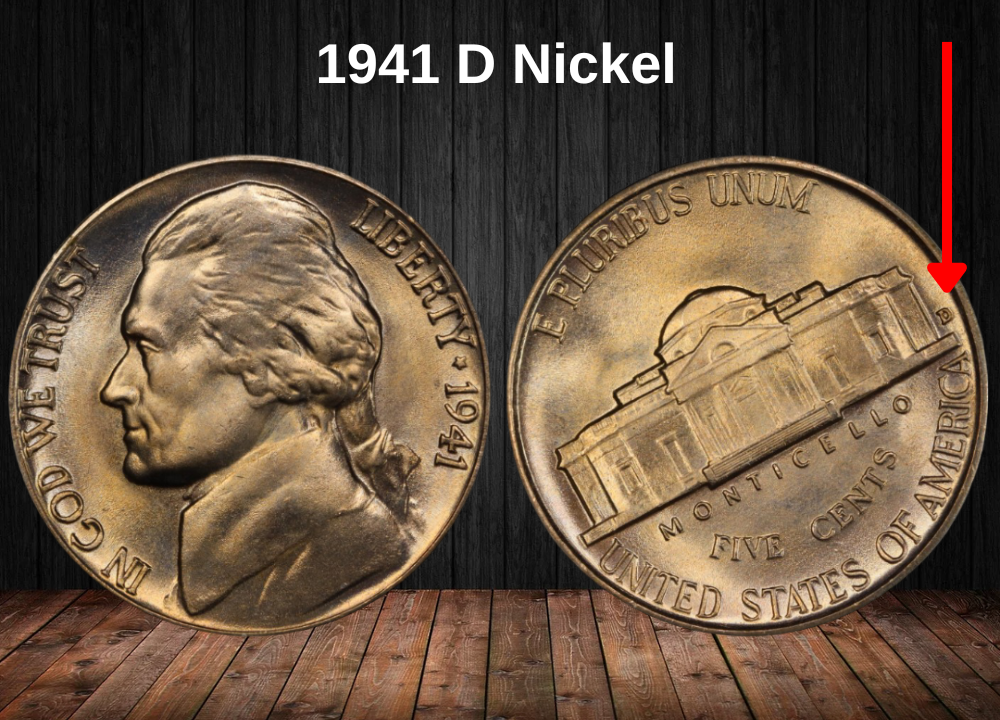
In 1941, the Denver Mint produced a total of 53,432,000 Jefferson nickels, making it the second-largest mintage of that year. These coins bear the “D” mint mark on the reverse, next to Monticello.
While circulated examples are common and affordable, values rise sharply for high-grade coins—especially those with the coveted Full Steps (FS) designation.
Typical Market Value (Regular Strike)
Depending on condition, a standard 1941-D nickel can sell for $2.50 to $70 in the current coin market.
Full Steps (FS) Value by Grade
| Grade (FS) | Estimated Value |
|---|---|
| MS64 FS | $16 |
| MS65 FS | $26 |
| MS66 FS | $50 |
| MS67 FS | $175 |
| MS68 FS | Up to $8,250 |
One particularly well-preserved MS68 Full Steps example sold at Stack’s Bowers in 2018 for a staggering $11,400, making it one of the most valuable 1941-D Jefferson nickels ever sold.
If you come across a 1941-D nickel with sharp strike details and full Monticello steps, it’s well worth having the coin professionally graded—it could be worth far more than face value.
1941 S Nickel Value

The San Francisco Mint produced the smallest number of 1941 Jefferson nickels, with a total mintage of 43,445,000 coins bearing the “S” mint mark. Despite the lower production, these nickels generally remain affordable, with most examples selling between $2.70 and $250 depending on condition.
Full Steps (FS) 1941-S Nickels
Nickels exhibiting the prized Full Steps designation command higher prices, especially in mint state:
| Grade (FS) | Approximate Value |
|---|---|
| MS64 FS | $42 |
| MS65 FS | $80 |
| MS66 FS | $250 |
| MS67 FS | Up to $3,500 |
Among these, the MS67 Full Steps 1941-S nickel is the most valuable, with a notable sale at auction in 2006, where a collector paid $8,913 for one of these rare coins.
If you own a 1941-S nickel with sharp details and full Monticello steps, it’s worth having it professionally evaluated, as it could be quite valuable.
Rare 1941 Jefferson Nickel Error List
1941 Jefferson Nickel Doubled Die Error

Among the various coin errors, doubled dies are some of the most sought-after by collectors. These occur when the coin’s design is accidentally stamped twice, creating a visible doubling effect on letters or numbers.
While a few 1941 Jefferson nickels exhibit this doubled die characteristic, they are not particularly rare or highly valuable compared to other errors from different years. As a result, owning a 1941 doubled die nickel usually doesn’t translate into a significant increase in value.
If you spot this error, it’s still an interesting addition to your collection, but don’t expect a big payday for these coins from the 1941 mint.
1941 Jefferson Nickel Re-punched Mint Mark Error
During the early 1940s, mint marks were manually punched onto coins, leading to occasional imperfections known as re-punched mint marks (RPMs). These errors appear as double, triple, or even quadruple impressions of the mint mark, sometimes showing upside-down, sideways, or faint initial punches.
Most 1941 nickels with minor re-punched mint marks are valued between $3 and $5. However, coins exhibiting more pronounced or dramatic re-punching errors can command prices ranging from $20 to $25.
If you come across a 1941 nickel with unusual or overlapping mint marks, it’s worth having it examined—some RPM varieties attract special interest from collectors.
1941 Jefferson Nickel Off-Center Strike Error
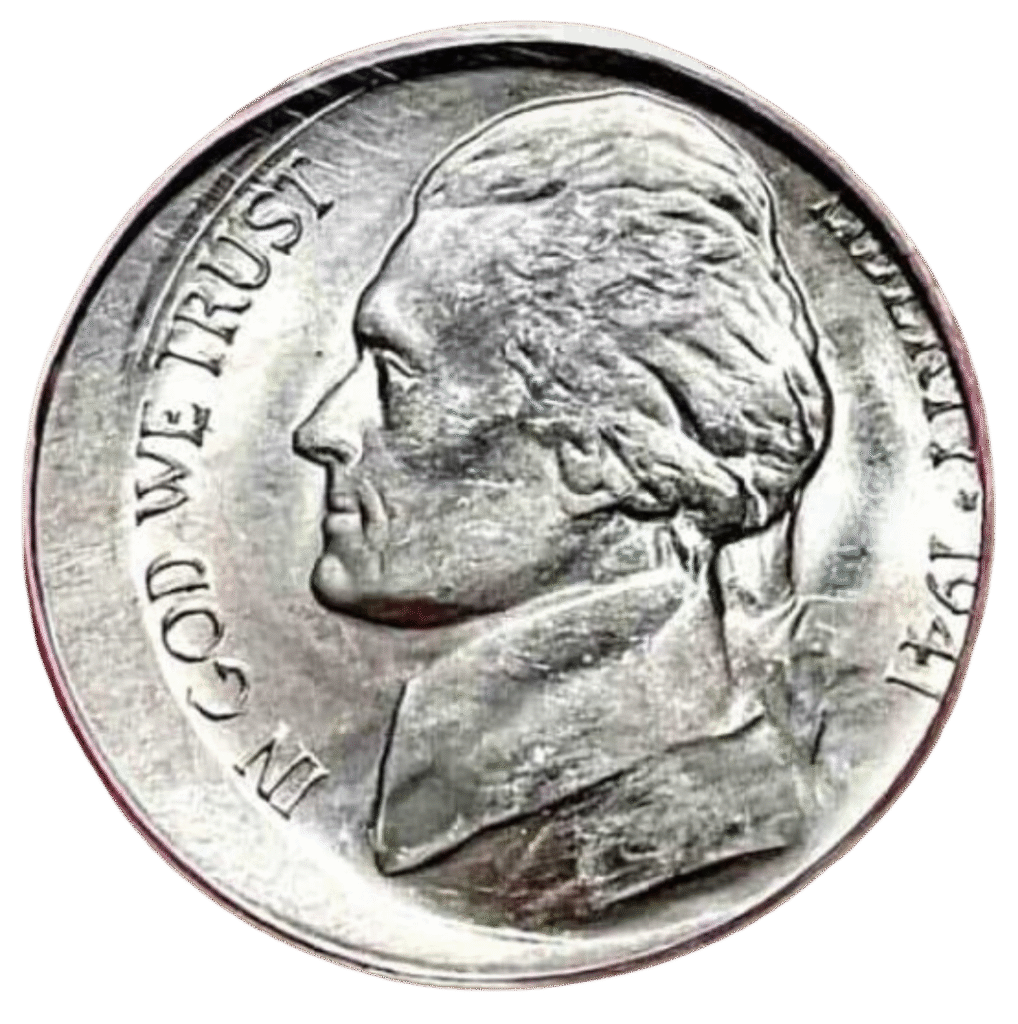
Off-center strike errors happen when the coin’s design is not properly aligned during minting, causing part of the image to be missing. The value of these errors varies based on how much of the design is off-center.
For a 1941 Jefferson nickel with a slight misstrike—about 5% to 10% off-center—collectors generally value it between $8 and $15. However, when the misalignment is more extreme, such as 50% of the design missing but with the date still visible, the coin’s value can increase dramatically, reaching $75 to $100.
The more dramatic the off-center strike, the more appealing it is to error coin collectors, so keep an eye out for these unique pieces.
1941 Jefferson Nickel Die Crack Error
Over time, the metal dies used to stamp coin designs can develop cracks due to repeated use. When a cracked die strikes a planchet, it leaves behind raised lines or ridges known as die cracks on the coin’s surface.
These cracks vary in size and location, and coins exhibiting prominent or unique die cracks have become collectible. The value of a 1941 Jefferson nickel with a die crack typically ranges from $1 up to $150, depending on the severity and position of the crack.
Collectors often seek out these subtle errors as interesting variations in coinage history.
Where to sell your nickel?
Now that you’re aware of your nickel’s value, you may be curious about the best places to sell it. Don’t worry: here’s a rundown of some top online marketplaces where you can conveniently sell your nickels, along with their benefits and drawbacks.
Explore the best platforms for selling nickels online (advantages and disadvantages).
FAQ about the 1941 Jefferson Nickel Value
1. How does die variety or die state affect the value of the 1941 Jefferson Nickel?
Die varieties and the state of the die (early vs. late strikes) can significantly impact value. Early die states tend to have sharper details, while late die states may show die wear or cracks. Some subtle die differences are sought after by specialists and can add premiums to the coin’s value.
2. What role does the “full steps” (FS) designation play in grading and valuing a 1941 Jefferson Nickel?
The “Full Steps” designation refers to fully struck horizontal lines on Monticello’s steps on the reverse. Coins with FS have better strike quality, which increases collector desirability and value. FS is often a prerequisite for top-grade nickels and can add 10–30% or more to the coin’s worth.
3. Are there known doubled die varieties or overdates for the 1941 Jefferson Nickel?
While doubled dies are common in other Jefferson Nickel years, no major doubled die or overdate varieties are widely recognized for 1941. However, minor doubling or hub doubling anomalies may exist and can be of interest to die variety collectors if authenticated.
4. How did wartime metal composition changes impact the collectibility and value of 1941 Jefferson Nickels?
The 1941 nickels still used the standard 75% copper and 25% nickel alloy. However, 1942 saw a switch to silver war nickels due to wartime metal demands. This makes the 1941 coins the last of the “regular” composition pre-war issues, increasing their historical significance and desirability.
5. What impact does provenance or pedigree have on the value of a 1941 Jefferson Nickel?
Coins with documented provenance—such as being part of a famous collection or previous auction—often command higher prices due to verified authenticity and collector interest. Pedigree adds a layer of trust and prestige, which can be especially important for rare or high-grade 1941 nickels.
6. How do grading nuances between major services (PCGS, NGC, ANACS) influence 1941 Jefferson Nickel market value?
Each grading service has slight differences in standards and market perception. PCGS and NGC graded coins often fetch higher prices due to their wider collector base and stronger brand recognition, while ANACS can be a good option for more affordable grading. Subtle grading differences can cause noticeable value fluctuations.
7. What should advanced collectors look for when verifying originality and detecting counterfeit 1941 Jefferson Nickels?
Experts examine details like mint mark placement, strike quality, patina, and weight. Advanced tools include microscopic analysis and X-ray fluorescence (XRF) testing for metal content. Counterfeits may have incorrect mint marks, altered dates, or improper alloy composition, which careful study can reveal.
Related post:

